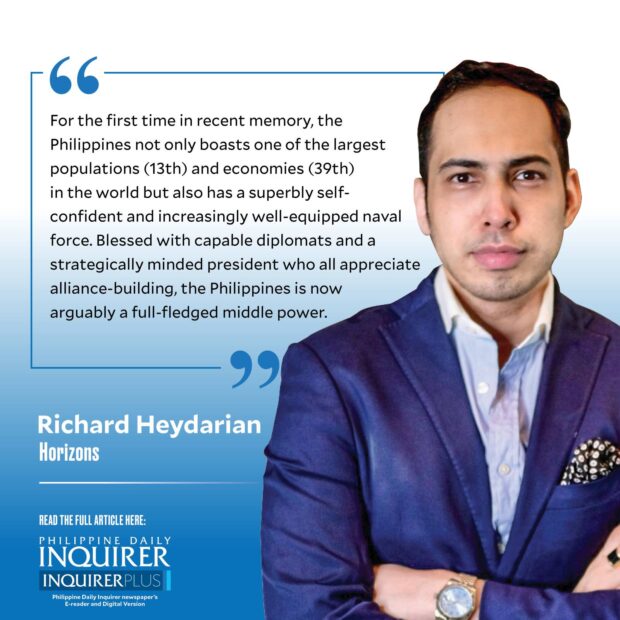Philippines: A new ‘middle power’?
 The strong do what they can and the weak suffer what they must,” lamented Greek historian Thucydides after observing the tragic fate of smaller city-states at the hands of Athenian and Spartan armies. Over the next two millennia, countless self-styled “realists” invoked Thucydides’ memorable lines in order to justify a full range of imperialist enterprises, which reduced much of humanity to, at best, bystanders, and, at worst, pawns in great power rivalries.
The strong do what they can and the weak suffer what they must,” lamented Greek historian Thucydides after observing the tragic fate of smaller city-states at the hands of Athenian and Spartan armies. Over the next two millennia, countless self-styled “realists” invoked Thucydides’ memorable lines in order to justify a full range of imperialist enterprises, which reduced much of humanity to, at best, bystanders, and, at worst, pawns in great power rivalries.
More subtle thinkers, however, would know Thucydides wasn’t the only major thinker in the ancient era, even among Greeks. Throughout centuries, countless Greek thinkers rejected simplistic, binary divisions of the world into the “strong” and the “weak.” In fact, many spoke of how major powers, or “magnates,” such as Sparta or Persia had to contend with middle-sized yet influential polities such as Syracuse and Corinth.
As historian Peter Frankopan beautifully illustrates in “Silk Roads” (2017), mezano (mid-sized) city-states such as Venice, Genoa, and Florence were pivotal to global commerce and Eurasian geopolitics during the Medieval and Renaissance periods.
At the dawn of modernity, thinkers such as L’Abbé de Mably also spoke of the role of “second-order” puissances (powers) in shaping European politics. This was fully on display during the 1815 Paris Conference, where midsized Germanic states played a critical role in shaping the post-Napoleonic order in Europe. Over the past century, midsized powers such as Australia and Canada have made major contributions to disarmament, deescalation of major power conflicts, and deterrence of mass atrocities.
“Middle powers” come in various forms and shapes, but as scholars such as John Ravenhill and Gareth Evans have argued, they have three things in common: namely (i) capacity for robust self-defense, if not projection of power in their near-neighborhood; (ii) coalition-building skills through proactive diplomacy; and (iii) credibility and creativity in advocating for positive-sum cooperation on issues of global concern.
In the words of Italian thinker Giovanni Botero, middle powers have “sufficient strength and authority” to exercise agency in international affairs. And this, dear reader, brings us to the topic at hand: Is the Philippines a “middle power”? At least two major think tanks, namely the Lowy Institute (Australia) and Hague Center for Strategic Studies (Netherlands), classify our country as a middle power.
Recently, I had the privilege of personally observing our country’s rapidly growing defense capabilities, thanks to an invitation by the Philippine Navy to visit our most modern warships, now parked at the ex-Hanjin shipyard in Subic Bay Freeport.
I witnessed modern warships equipped with state-of-the-art weapons systems. Aboard BRP Jose Rizal, one of the warships built by South Korea, I saw jolly officers beaming with pride. Far from marooned soldiers, what I saw were neatly dressed, unpretentiously articulate, and unabashedly patriotic Filipinos, who proudly shared their countless stories of standing up to bullies in the West Philippine Sea.
Commanding officers such as Captains Noli Ibanez (BRP Rizal) and Oliver Obongen (BRP Tarlac) seamlessly projected leadership and gently explained the countless ways by which they protect our waters from predators and aid our people against natural disasters. As a bonus, I even got to meet a distant relative from the north, Lt. Col. Ferdinand Foronda.
On his part, Philippine Navy spokesperson Captain Benjo Negranza was the epitome of competence and cordiality.
“Part of our military modernization program is ensuring we have naval operating bases for our capital ships,” he explained, when asked about the importance of the new Philippine Navy facility in Subic.
“It’s not only about acquiring platforms but also where to park them. Fortunately, now we have berthing facilities for our capital ships,” he added, patiently explaining how different pieces are coming together for our naval forces.
When I asked him about learning experiences from recent conflicts from the South Caucasus to Ukraine, where new-generation drones have played a central role, he confidently explained how they are “taking into consideration contemporary trends in warfare to ensure the country can better adapt to new threats and warfare technologies.”
For the first time in recent memory, the Philippines not only boasts one of the largest populations (13th) and economies (29th) in the world but also has a superbly self-confident and increasingly well-equipped naval force. Blessed with capable diplomats and a strategically minded president who appreciate alliance-building, the Philippines is now arguably a full-fledged middle power.
rheydarian@inquirer.com.ph
















